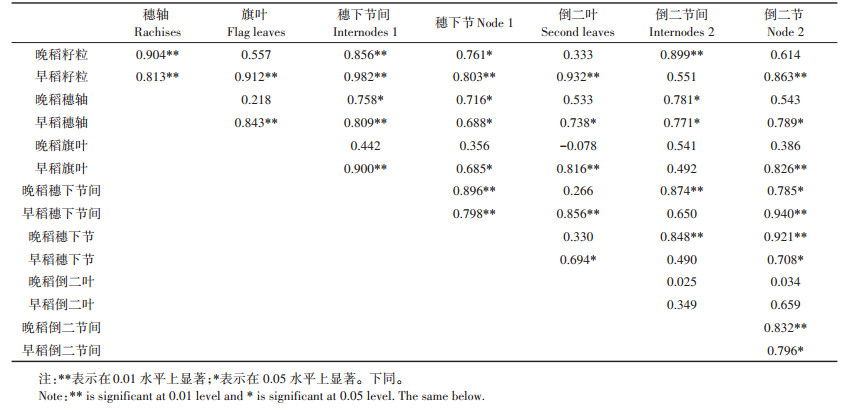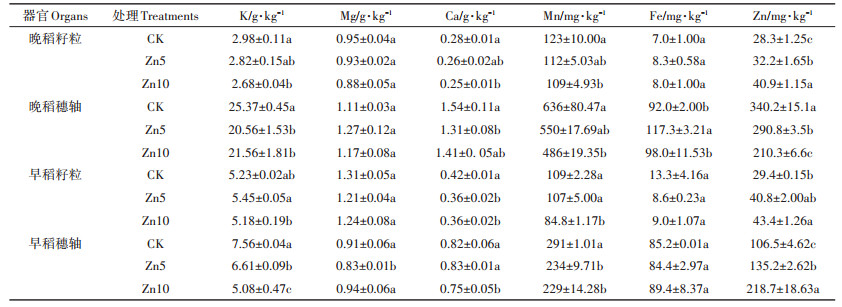2. 湖南省湘潭市农业科学研究所, 湖南 湘潭 411134
2. Xiangtan City Agricultural Science Research Institute, Xiangtan 411134, China
湖南被称为“有色金属之乡”,矿产资源在开采过程中排出的废气和废水,能通过大气沉降和灌溉过程进入到农田中,日积月累,使农田中的镉(Cd)含量越来越高[1-2]。由于Cd的生物活性比较强,能被水稻等作物吸收富集,所以很容易通过食物链进入人体,从而对人体健康造成威胁[3]。
叶面喷施微量元素不仅能够促进水稻籽粒对微量元素的积累,还能降低各部分的Cd含量[4-5]。锌(Zn)作为植物生长所必需的微量元素,在植物的生长发育过程中不仅能促进作物的生长发育,还参与了碳水化合物的代谢、蛋白质的代谢以及叶绿素的合成等过程[6]。Cd2+与Zn2+作为二价阳离子,化学性质比较相似,其在植物体内的吸收和积累存在一定的相互作用[7]。有研究表明,在水稻叶面喷施ZnSO4能够提高水稻叶面的光合作用、缓解Cd对植物的生理毒害[8],甚至降低籽粒对Cd的积累[9-10];喷施Zn还能提高籽粒中的Zn含量,改善人体缺Zn的状况[11-12]。
水培试验和盆栽试验结果表明,Zn对水稻Cd的吸收转运具有明显的调节作用,营养液中添加氯化锌、叶面喷施Zn肥或者在Cd污染土壤中施加Zn肥都能够降低水稻的Cd含量[7, 13-16]。田间施用锌肥或土壤钝化剂中配施ZnSO4肥料,能有效降低小麦、豇豆和烟草等作物对Cd的吸收[17-19]。叶面喷施Zn肥对水稻籽粒中的Cd含量也有明显的抑制效果[20]。但在田间自然条件下,叶面喷施ZnSO4是否能够对不同类型水稻地上部多个器官的Cd积累特性以及其他必需元素的含量产生影响,尚缺乏系统的研究。因此,本研究以Cd污染农田中种植的早稻和晚稻为材料,通过在水稻开花期叶面喷施不同浓度的ZnSO4,对其降Cd效果及其在早稻和晚稻间的差异进行了比较,以期为降Cd富Zn叶面肥的研发提供参考。
1 材料和方法 1.1 供试土壤和作物在湖南省湘潭市重金属污染农田(28°42′ N,112°51′E),分别以早稻品种中早35和晚稻品种华占为试验材料进行叶面喷施试验。供试土壤为红壤性水稻土,表层土壤(0~20 cm)的基本理化性质为:pH 5.5,有机质含量41.54 g·kg-1,阳离子交换量(CEC)为19.55 cmol·kg-1,土壤Cd含量为0.69 mg·kg-1。湘潭属中亚热带季风湿润气候区,降水量较充沛,早稻和晚稻分别在三月份和七月份进行播种,六月中旬和九月中旬分别进入抽穗开花期。当地田间施肥方法依照水稻的测土配方施肥技术,其中每667 m2施用的氮磷钾肥总量分别为:尿素27 kg、普钙40 kg、氯化钾15 kg,整个生育期各处理无明显病虫害发生,采用化学除草剂去除杂草。
1.2 试验设计与处理试验采用顺序排列,每个小区面积为5.00 m2,长为2.50 m,宽为2.00 m。设置试验为1个对照组(CK)和2个处理组,处理组1喷施1 L浓度为5 mmol·L-1 ZnSO4,处理组2喷施1 L浓度为10 mmol·L-1 ZnSO4,每个处理组设置3个重复。水稻开花期后,分别将配制好的5 mmol·L-1和10 mmol·L-1的ZnSO4溶液倒入容积为1 L的手持式喷壶中,调整喷壶使其喷出雾状水雾,进而将ZnSO4均匀地喷施在水稻叶面上,对照组喷施1 L自来水(CK)。待水稻成熟后,采集不带根系的水稻植株。水稻自然晾干后,将水稻植株分为籽粒、穗轴、旗叶、穗下节间、穗下节、倒二节、倒二节间、倒二叶共八部分,放入烘箱在70 ℃的条件下烘干。
1.3 水稻各部位Cd含量和其他必需元素含量的测定参照Liu等[21]的方法,称取0.5 g植株样品放入消煮管中,加入7 mL的HNO3浸泡过夜,110 ℃消煮2.5 h,加入1 mL 30%H2O2之后继续110 ℃煮1.5 h,之后升温赶酸定容。使用ICP-MS(Agilent 7500a,USA)测定土壤和植物各器官中的Cd、K、Ca、Mg、Fe、Mn和Zn的元素含量。
1.4 数据的处理和分析采用Excel和SPSS 19.0软件进行试验数据的处理以及显著性分析,并用Origin 8.0软件绘制图表。
2 结果与分析 2.1 ZnSO4对水稻各器官Cd含量的影响Cd含量在早稻和晚稻之间以及水稻各器官间存在明显的差异,晚稻各部分的Cd含量明显高于早稻,穗轴中的Cd含量明显高于籽粒中的Cd含量(图 1A);穗下节和倒二节中富含大量的Cd(图 1B)。晚稻和早稻各处理穗下节中的Cd含量是旗叶和穗下节间中Cd含量的10倍左右,倒二节中的Cd含量是倒二节间中Cd含量的3倍左右(图 1C、图 1D)。
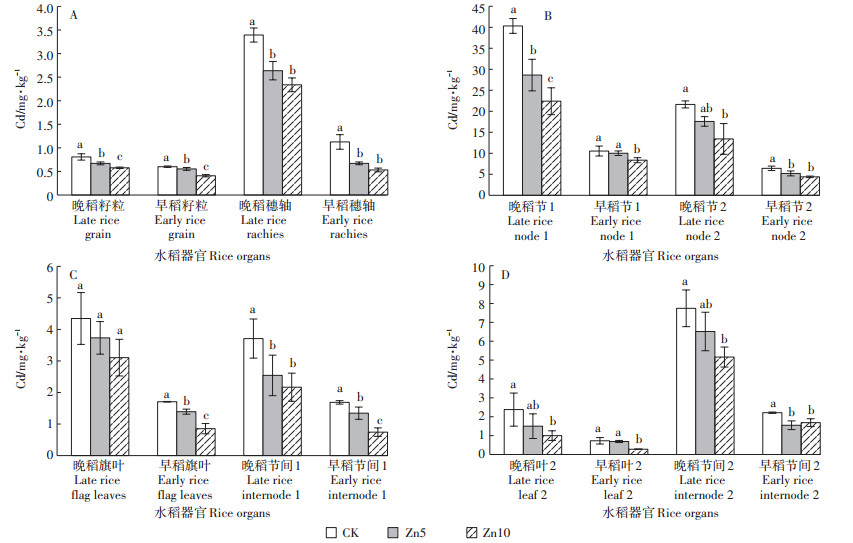
|
节1和节2分别代表穗下节和倒二节;节间1和节间2分别代表穗下节间和倒二节间;叶2代表倒二叶;不同字母表示处理间差异达到5%显著水平(n=3)。下同 Node 1 and node 2 represent the uppermost nodes and second nodes; internode 1 and internode 2 represent the uppermost internodes and second internodes; leaf 2 represents the second leves; Different letters indicate significant difference among different treatments at 5% level (n=3)。The same blow 图 1 ZnSO4浓度(Zn5和Zn10)对晚稻和早稻不同器官中Cd含量的影响 Figure 1 Effects of ZnSO4(Zn5和Zn10)on Cd concentrations in different organs of late rice and early rice |
开花期叶面喷施5 mmol·L-1和10 mmol·L-1的ZnSO4,使成熟期籽粒、穗轴、旗叶、穗下节间、穗下节、倒二节间、倒二节中的Cd含量显著下降,且随着Zn浓度的增加其降Cd效果更为明显。与对照相比,喷施5 mmol·L-1和10 mmol·L-1的ZnSO4使晚稻籽粒Cd含量分别下降16.93%和28.52%,穗轴Cd含量分别下降22.30%和31.14%;使早稻籽粒Cd含量分别下降7.81%和32.00%,穗轴中的Cd含量分别下降40.34%和52.79%。此外,与对照相比,喷施5 mmol·L-1和10 mmol·L-1的ZnSO4明显抑制了早稻穗下节中Cd向穗下节间的转运,喷施10 mmol·L-1的ZnSO4抑制了晚稻穗轴中的Cd向籽粒的转运,以及抑制了早稻旗叶中的Cd向穗轴的转运。
2.2 水稻不同器官Cd含量的相关性分析由表 1可以看出,湘潭晚稻籽粒Cd含量和穗轴Cd含量、穗下节间Cd含量、倒二节间Cd含量呈极显著(P<0.01)正相关;穗轴和穗下节间、穗下节Cd含量呈显著(P<0.05)正相关;穗下节间和穗下节、倒二节间Cd含量呈极显著(P<0.01)正相关(表 1);穗下节和倒二节间、倒二节呈极显著(P<0.01)正相关,倒二节间和倒二节呈极显著(P<0.01)正相关,其他器官之间其Cd含量并没有表现出明显的相关性。
|
|
表 1 晚稻和早稻不同器官中Cd含量的相关性 Table 1 Correlation between Cd concentrations in different organs of late rice and early rice |
早稻籽粒Cd含量和穗轴、旗叶、穗下节间、穗下节、倒二叶、倒二节都呈极显著(P<0.01)正相关;穗轴Cd含量与旗叶和穗下节间Cd含量呈极显著(P<0.01)正相关,相关系数分别为0.843**、0.809**(表 1);旗叶和穗下节间、倒二叶、倒二节呈极显著(P<0.01)正相关;穗下节间Cd含量和穗下节、倒二叶、倒二节Cd含量呈极显著(P<0.01)正相关;此外,除穗轴外,其余各部分Cd含量与倒二节间中Cd含量并没有表现出明显的相关性,这表明籽粒对Cd的吸收积累与穗轴以及穗下节间和穗下节关系密切。
2.3 Zn离子对水稻籽粒和穗轴其他必需元素含量的影响K是水稻各部位中含量最丰富的离子,晚稻穗轴K含量明显高于籽粒,这说明只有一小部分K转移到了籽粒中,叶面喷施ZnSO4使籽粒和穗轴中的K含量略有降低。Mg是稻米中第二大丰富的元素,叶面喷施ZnSO4使晚稻穗轴中的Mg含量略有增加,但对早稻和晚稻籽粒中的Mg含量无显著影响。籽粒和穗轴中的Ca和Mn元素含量都随着Zn的喷施而降低,喷施10 mmol·L-1的Zn能显著降低稻米中的Ca和Mn含量。喷施ZnSO4增加了籽粒和穗轴中的Fe元素含量,并显著提升了籽粒中的Zn含量,喷施5 mmol·L-1和10 mmol·L-1的Zn肥使晚稻籽粒中的Zn含量分别增加13.81%和44.60%(表 2)。
|
|
表 2 ZnSO4(Zn5和Zn10)对晚稻和早稻籽粒及穗轴K、Mg、Ca、Mn、Fe、Zn含量的影响 Table 2 Effects of ZnSO4(Zn5和Zn10)on concentrations of K, Mg, Ca, Mn, Fe, Zn in grains and rachises of late rice and early rice |
对于早稻而言,籽粒中的K含量高于晚稻籽粒,而穗轴中K元素含量明显低于晚稻穗轴中的K含量,其他元素早稻和晚稻差距不大。喷施5 mmol·L-1的ZnSO4使籽粒和穗轴中的Mg、Ca、Mn、Fe略有下降,但是籽粒Mg、Mn、Fe差异未达到显著水平,穗轴的Ca和Fe未达到显著水平。喷施10 mmol·L-1的ZnSO4使籽粒K、Ca和Mn的含量显著下降。喷施5 mmol·L-1和10 mmol·L-1的锌肥使早稻籽粒中的Zn含量分别增加39.02%、47.88%,穗轴中的Zn含量分别增加26.93%和105.00%。
Mn、Zn两种元素在水稻各器官中呈现出不同的分布特征,喷施Zn肥影响了其在水稻体内的分布。在晚稻Cd污染农田中,Mn、Zn两种元素都表现为穗下节和倒二节中含量最高,与对照相比,叶面喷施Zn肥使除旗叶和倒二叶外的其他部分的Mn含量呈现降低的趋势(表 3),同时各部分Cd和Mn表现为正相关。Zn在籽粒、旗叶、穗下节、倒二叶、倒二节中的含量都随着Zn含量的增加呈增加的趋势。K元素表现为穗下节间和倒二节间含量最高,为50~72 g·kg-1(图 2A),其余各器官中K元素在不同处理间差异不显著。Ca和Fe元素都是在旗叶和倒二叶中的含量比较高(图 2B、图 2D),但是各器官中Ca、Fe和Mg元素也没有随着处理的变化产生明显的差异性。
|
|
表 3 ZnSO4(Zn5和Zn10)对晚稻各器官Mn和Zn分布的影响 Table 3 Effects of ZnSO4(Zn5和Zn10) on Mn and Zn concentrations in different organs of late rice |
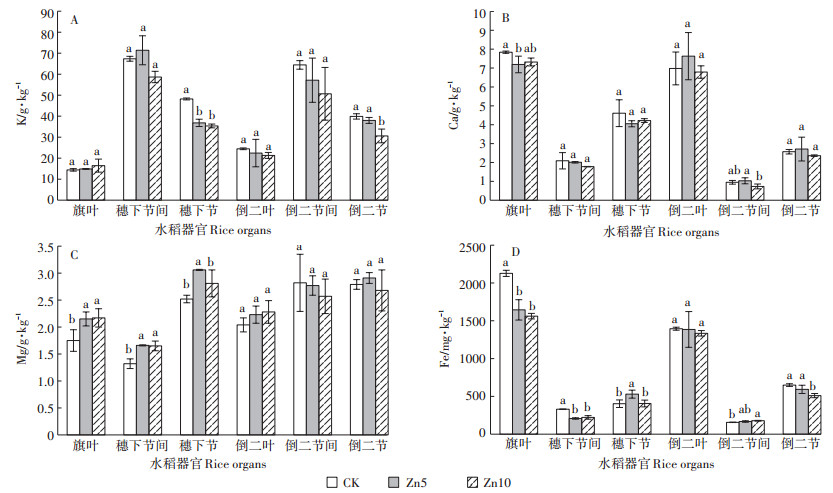
|
图 2 喷施ZnSO4(Zn5和Zn10)对晚稻各器官中K、Ca、Mg和Fe分布的影响 Figure 2 Effects of ZnSO4(Zn5和Zn10)on the distribution of K, Ca, Mg and Fe indifferent organs of late rice |
在早稻中,Mn元素在倒二叶和倒二节中的含量比较高,其次是旗叶和穗下节中含量。Zn元素同晚稻一致,表现为穗下节和倒二节中含量最高,在籽粒、穗轴、旗叶中的含量都随着Zn含量的增加呈增加的趋势(表 4)。K元素同样表现为穗下节间和倒二节间中的含量最高,为39~62 g·kg-1(图 3A),并且随着Zn浓度的增加呈现增加的趋势,其余各器官中K元素在不同处理间并没有表现出明显的差异性。Ca元素与晚稻趋势一致,表现为旗叶和倒二叶中含量最高(图 3B),但是各器官中Ca和Mg元素也没有随着处理的变化产生明显的差异性。
|
|
表 4 ZnSO4(Zn5和Zn10)对早稻各器官Mn和Zn分布的影响 Table 4 Effects of ZnSO4(Zn5和Zn10)on Mn and Zn concentrations in different organs of early rice |
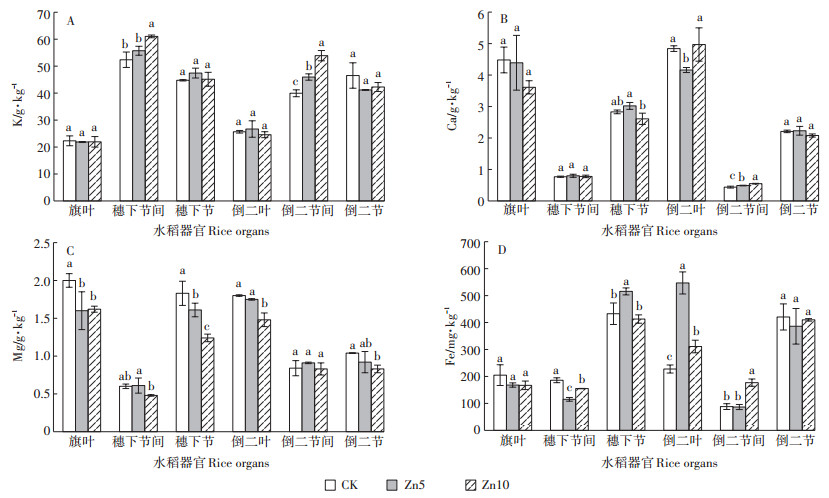
|
图 3 ZnSO4(Zn5和Zn10)对早稻各器官中K、Ca、Mg和Fe分布的影响 Figure 3 Effects of ZnSO4(Zn5和Zn10)on the distribution of K, Ca, Mg and Fe in different organs of early rice |
早稻和晚稻籽粒中的Cd元素与其他元素间的相关性不同(表 5)。晚稻籽粒中的Fe元素与籽粒中的Cd呈负相关,但不显著;Zn与Cd呈极显著负相关,其相关系数为-0.833**;K和Mg与Cd呈显著正相关,Mn与Cd呈正相关,但是相关性不显著。早稻籽粒中的Mn与Cd呈极显著正相关,相关系数为0.908**,籽粒中的Zn与Cd呈负相关,其他各元素与Cd的相关性不显著。
|
|
表 5 早稻和晚稻籽粒中Cd含量与其他元素含量的相关系数 Table 5 Correlation coefficients between Cd content of other elements in rice grains |
水稻籽粒中的Cd含量通常与土壤中有效态Cd含量呈正相关,然而,降雨量对土壤中有效态Cd含量有显著影响[22-23]。本研究发现,晚稻各器官的Cd含量明显高于早稻,这可能是由于湖南地处亚热带季风气候区,年平均降水量在1500 mm左右,一半以上的降水量集中在3月到7月之间。早稻根系土壤周围的Cd离子在降水量较高时可能更容易沉降到深层土壤中[24-25],同时,降水量的增加还会降低植物的蒸腾作用,减少通过蒸腾拉力向旗叶和穗部转运的Cd离子数量,从而减少了早稻籽粒中Cd的积累。相反,晚稻灌浆期间气候干燥,蒸腾作用比较强,这可能会促进Cd由土壤深层向地上部的转运[26-28]。因此,灌浆期间降水量的差异可能是致使晚稻和早稻之间各部位中Cd含量不同的主要环境因素。
水稻在其成熟的过程中,存储于各营养器官中的部分营养元素会被迁移转运到籽粒中[29-30]。穗下节和倒二节对Cd从木质部到韧皮部的转运起主要的调节作用[31],节中的转运蛋白对某些矿质营养元素的转运也起着重要的调节作用[32-34]。穗轴是连接水稻茎秆和籽粒的部位,根系和叶片中的营养元素都会通过穗轴转运到籽粒中,水稻籽粒中的Cd含量与穗轴中的Cd含量呈极显著正相关[14]。本试验发现,籽粒中的Cd含量与穗轴、节以及节间中的Cd含量相关性比较高,通过穗下节的固定,穗下节间、旗叶和穗轴中的Cd含量明显降低。此外,无论是雨水充沛的早稻灌浆期,还是秋高气爽的晚稻灌浆期,开花期喷施Zn离子后,都能显著降低稻米中的Cd含量。这可能是由于Zn与Cd为同族元素,它们的化学性质相似,当Zn2+与Cd2+同时竞争相同的转运蛋白时,膜蛋白会优先结合水稻生长发育所必需的Zn2+,从而抑制了Cd2+从旗叶向穗轴和籽粒的转运。此外,喷施Zn还可能抑制了水稻的蒸腾作用,从而对Cd的吸收、运输和再分配产生影响[20, 35-36];同时,细胞壁中的[Si-半纤维素-Zn]络合物能和Cd产生共沉淀,将Cd固定在节、茎秆和叶片等器官的细胞壁中,从而抑制了Cd在细胞间的转运[37-38]。
水稻体内Cd的转运与其他营养元素的吸收转运有着密切的关系。细胞膜上的转运蛋白以及离子通道不仅能够转运多种植物所需的必需元素例如K+、Zn2+、Ca2+、Mg2+、Mn2+,还能转运一些非必需元素,如Cd2+[39-40]。Cd不仅能够抑制植物的生长,还能够抑制其他必需元素的吸收积累从而造成植物细胞的死亡。本研究发现,水稻开花期喷施5~10 mmol·L-1的ZnSO4不仅增加了晚稻和早稻籽粒中的Zn含量;还增加了晚稻籽粒和穗轴中的Fe含量,这可能是因为进入叶片的Zn加强了锌铁转运蛋白(ZIP)的活性,促进了其对Zn和Fe的亲和力,提高了其转运率[41-42]。此外,晚稻籽粒中的Cd含量与籽粒中的K和Ca正相关,早稻籽粒中的Cd含量与Ca和Mn显著正相关,这说明大多数的Cd都能通过Mn、K、Ca离子通道或者转运通道进入水稻籽粒中,并伴随着这些元素的降低而减少。因此,叶面喷施ZnSO4,既可以通过增加籽粒中Zn2+浓度,与Cd2+竞争离子通道,从而直接抑制Cd的吸收和转运,也可以通过影响籽粒和穗轴中其他必需元素的积累,间接地抑制水稻籽粒对Cd的吸收和积累。
4 结论(1)晚稻籽粒和穗轴中的Cd含量都显著高于早稻,水稻开花期喷施ZnSO4能显著降低晚稻和早稻籽粒中的Cd含量。与对照相比,喷施5 mmol·L-1和10 mmol·L-1的ZnSO4使晚稻籽粒Cd含量分别下降16.93%和28.52%;使早稻籽粒Cd含量分别下降7.81%和32.00%。
(2)穗下节是Cd含量最高的地上部器官,对穗轴和籽粒中的Cd含量有显著影响。喷施5 mmol·L-1和10 mmol·L-1 Zn能使晚稻穗下节Cd含量(40.32 mg·kg-1)分别下降29.00%和44.44%,早稻穗下节Cd含量(10.53 mg·kg-1)分别下降4.89%和20.66%。通过穗下节的固定,穗下节以上的节间、穗轴和籽粒中的Cd含量大幅度下降。
(3)叶面喷施ZnSO4,既能增加籽粒中Zn2+浓度,也能影响籽粒和穗轴中Fe、Ca、Mn等必需元素的含量。
| [1] |
Gui Li, Fang-Ping T, Zhen-Hua L. Analysis on pollution of heavy metal in Shuikoushan Pb-Zn mining and smelting area in Hengyang[J]. Journal of Central South University of Forestry & Technology, 2012, 32(7): 105-109. |
| [2] |
阮玉龙, 李向东, 黎廷宇, 等. 喀斯特地区农田土壤重金属污染及其对人体健康的危害[J]. 地球与环境, 2015, 43(1): 92-97. RUAN Yu-long, LI Xiang-dong, LI Ting-yu, et al. Heavy metal pollution in farmland soil and its harm to human health in karst area[J]. Earth and Environment, 2015, 43(1): 92-97. |
| [3] |
Kerkhove E V, Valérie Pennemans, Swennen Q. Cadmium and transport of ions and substances across cell membranes and epithelia[J]. Biometals, 2010, 23(5): 823-855. DOI:10.1007/s10534-010-9357-6 |
| [4] |
贺前锋, 李鹏祥, 易凤姣, 等. 叶面喷施硒肥对水稻植株中镉、硒含量分布的影响[J]. 湖南农业科学, 2016(1): 37-39. HE Qian-feng, LI Peng-xiang, YI Feng-jiao, et al. Effects of selenium fertilizer foliage application on distribution of cadmium and selenium in rice[J]. Hunan Agricultural Sciences, 2016(1): 37-39. |
| [5] |
宋安军.镉污染条件下叶面喷施水杨酸、镁、谷氨酸对水稻镉等元素积累的影响[D].成都: 四川农业大学, 2015. SONG An-jun. Effect of foliar spraying salicylicacid, magnesium and glutamic acid on the cadmium accumulation of cadmium and other elements in rice was influenced by cadmium pollution[D]. Chengdu: Sichuan Agricultural University, 2015. http://cdmd.cnki.com.cn/Article/CDMD-10626-1016048996.htm |
| [6] |
Ishimaru Y, Bashir K, Nishizawa N K. Zn uptake and translocation in rice plants[J]. Rice, 2011, 4(1): 21-27. DOI:10.1007/s12284-011-9061-3 |
| [7] |
尹洁, 赵艳玲, 徐莜, 等. 锌对粳稻幼苗镉吸收转运特性的影响[J]. 农业环境科学学报, 2016, 35(5): 834-841. YIN Jie, ZHAO Yan-ling, XU You, et al. Effects of zinc supply on absorption and translocation of cadmium in rice seedlings[J]. Journal of Agro-Environment Science, 2016, 35(5): 834-841. |
| [8] |
辜娇峰, 杨文弢, 周航, 等. 外源锌刺激下水稻对土壤镉的累积效应[J]. 环境科学, 2016, 37(9): 3554-3561. GU Jiao-feng, YANG Wen-tao, ZHOU Hang, et al. Provoking effects of exogenous Zn on cadmium accumulation in rice[J]. Environmental Science, 2016, 37(9): 3554-3561. |
| [9] |
Chaney R, Reeves P J, Simmons R, et al. An improved understanding of soil Cd risk to humans and low cost methods to phytoextract Cd from contaminated soils to prevent soil Cd risks[J]. Biometals, 2004, 17(5): 549-553. DOI:10.1023/B:BIOM.0000045737.85738.cf |
| [10] |
史静, 潘根兴, 张乃明. 镉胁迫对不同杂交水稻品种Cd/Zn吸收与积累的影响[J]. 环境科学学报, 2013, 33(10): 2904-2910. SHI Jing, PAN Gen-xing, ZHANG Nai-ming. Effect of cadmium stress on Cd and Zn uptake and accumulation of different cultivars of hybrid rice[J]. Acta Scientiae Circumstantiae, 2013, 33(10): 2904-2910. |
| [11] |
付力成, 王人民, 孟杰, 等. 叶面锌/铁配施对水稻产量/品质及锌铁分布的影响及其品种差异[J]. 中国农业科学, 2010, 43(24): 5009-5018. FU Li-cheng, WANG Ren-min, MENG Jie, et al. Effect of foliar application of zinc and iron fertilizers on distribution of zinc and iron, quality and yield of rice grain[J]. Scientia Agricultura Sinica, 2010, 43(24): 5009-5018. DOI:10.3864/j.issn.0578-1752.2010.24.004 |
| [12] |
Brown K H, Rivera J A, Bhutta Z, et al. International zinc nutrition consultative group(IZiNCG)technical document #1. Assessment of the risk of zinc deficiency in populations and options for its control[J]. Food & Nutrition Bulletin, 2004, 25(2): 99-203. |
| [13] |
索炎炎, 吴士文, 朱骏杰, 等. 叶面喷施锌肥对不同镉水平下水稻产量及元素含量的影响[J]. 浙江大学学报(农业与生命科学版), 2012, 38(4): 449-458. SUO Yan-yan, WU Shi-wen, ZHU Jun-jie, et al. Effects of foliar Zn application on rice yield and element contents under different Cd levels[J]. Journal of Zhejiang University(Agric. & Life Sci.), 2012, 38(4): 449-458. |
| [14] |
曲荣辉, 张曦, 李合莲, 等. 不同锌水平对低剂量镉在水稻中迁移能力的影响[J]. 中国生态农业学报, 2016, 24(4): 517-523. QU Rong-hui, ZHANG Xi, LI He-lian, et al. Effects of zinc level on low dose cadmium transport in rice plant[J]. Chinese Journal of EcoAgriculture, 2016, 24(4): 517-523. |
| [15] |
胡坤, 喻华, 冯文强, 等. 中微量元素和有益元素对水稻生长和吸收镉的影响[J]. 生态学报, 2011, 31(8): 2341-2348. HU Kun, YU Hua, FENG Wen-qiang, et al. Effects of secondary, micro-and beneficial elements on rice growth and cadmium uptake[J]. Acta Ecologica Sinica, 2011, 31(8): 2341-2348. |
| [16] |
刘昭兵, 纪雄辉, 田发祥, 等. 碱性废弃物及添加锌肥对污染土壤镉生物有效性的影响及机制[J]. 环境科学, 2011, 32(4): 1164-1170. LIU Zhao-bing, JI Xiong-hui, TIAN Fa-xiang, et al. Effects and mechanism of alkaline wastes application and zinc fertilizer addition on Cd bioavailability in contaminated soil[J]. Chinese Journal of Environmental Science, 2011, 32(4): 1164-1170. |
| [17] |
Hart J J, Welch R M, Norvell W A, et al. Zinc effects on cadmium accumulation and partitioning in near-isogenic lines of durum wheat that differ in grain cadmium concentration[J]. New Phytologist, 2005, 167(2): 391-401. DOI:10.1111/j.1469-8137.2005.01416.x |
| [18] |
丁琼, 杨俊兴, 华珞, 等. 不同钝化剂配施硫酸锌对石灰性土壤中镉生物有效性的影响研究[J]. 农业环境科学学报, 2012, 31(2): 312-317. DING Qiong, YANG Jun-xing, HUA Luo, et al. Effects and mechanism of alkaline wastes application and zinc fertilizer addition on Cd bioavailability in contaminated soil[J]. Journal of Agro -Environment Science, 2012, 31(2): 312-317. |
| [19] |
曹晨亮, 王卫, 马义兵, 等. 钝化剂-锌肥降低烟草镉含量长期效果研究[J]. 土壤学报, 2015, 52(3): 628-636. CAO Chen-liang, WANG Wei, MA Yi-bing, et al. Effects of longterm amendment with passivant and zinc fertilizer on cadmium reduction in tobacco growing in a Cd contaminated field[J]. Acta Pedologica Sinica, 2015, 52(3): 628-636. |
| [20] |
龙思斯, 杨益新, 宋正国, 等. 三种类型阻控剂对不同品种水稻富集镉的影响[J]. 农业资源与环境学报, 2016, 33(5): 459-465. LONG Si-si, YANG Yi-xin, SONG Zheng-guo, et al. Effects of three inhibitors on the accumulation of cadmium in rice[J]. Journal of Agricultural Resources and Environment, 2016, 33(5): 459-465. |
| [21] |
Liu Y, Zhang C, Zhao Y, et al. Effects of growing seasons and genotypes on the accumulation of cadmium and mineral nutrients in rice grown in cadmium contaminated soil[J]. Science of the Total Environment, 2017, 579: 1282-1288. DOI:10.1016/j.scitotenv.2016.11.115 |
| [22] |
Cao F, Wang R, Cheng W, et al. Genotypic and environmental variation in cadmium, chromium, lead and copper in rice and approaches for reducing the accumulation[J]. Science of the Total Environment, 2014, 496: 275-281. DOI:10.1016/j.scitotenv.2014.07.064 |
| [23] |
Du Y, Hu X F, Wu X H, et al. Affects of mining activities on Cd pollution to the paddy soils and rice grain in Hunan Province, Central South China[J]. Environmental Monitoring & Assessment, 2013, 185(12): 9843-9856. |
| [24] |
Shimojima E, Tamagawa I, Horiuchi M, et al. Observation of water and solute movement in a saline, bare soil, groundwater seepage area, Western Australia. Part 2. Annual water and solute balances[J]. Soil Research, 2015, 54(1): 78-93. |
| [25] |
Xiao Y, Huang Z, Yang F, et al. Dynamics of soil moisture and salt content after infilturation of saline ice meltwater in saline-sodic soil columns[J]. Pedosphere, 2017, 27(6): 1116-1124. DOI:10.1016/S1002-0160(17)60465-X |
| [26] |
Foster K J, Miklavcic S J. Modeling root zone effects on preferred pathways for the passive transport of ions and water in plant roots[J]. Front Plant Sci, 7: 914. DOI:10.3389/fpls.2016.00914 |
| [27] |
Fricke W. The significance of water co-transport for sustaining transpirational water flow in plants:A quantitative approach[J]. Journal of Experimental Botany, 2015, 66(3): 731-739. DOI:10.1093/jxb/eru466 |
| [28] |
Shrestha R K, Engel K, Becker M. Effect of transpiration on iron uptake and translocation in lowland rice[J]. Journal of Plant Nutrition and Soil Science, 2015, 178(3): 365-369. DOI:10.1002/jpln.201400361 |
| [29] |
Bahrani A, Joo M H. Flag leaf role in N accumulation and remobilization as affected by nitrogen in a bread and durum wheat cultivars[J]. American-Eurasian Journal of Agricultural and Environmental Sciences, 2010, 8(6): 728-735. |
| [30] |
Zhang C F, Peng S B, Rebecca C. Senescence of top three leaves in field-grown rice plants[J]. Journal of Plant Nutrition, 2003, 26(12): 2453-2468. DOI:10.1081/PLN-120025472 |
| [31] |
Fujimaki S, Suzui N, Ishioka N S, et al. Tracing cadmium from culture to spikelet:Noninvasive imaging and quantitative characterization of absorption, transport, and accumulation of cadmium in an intact rice plant[J]. Plant Physiology, 2010, 152(4): 1796-1806. DOI:10.1104/pp.109.151035 |
| [32] |
Zhao B H, Wang P, Zhang H X, et al. Source-sink and grain-filling characteristics of two-line hybrid rice Yangliangyou 6[J]. Rice Science (English version), 2006, 13(1): 34-42. |
| [33] |
Kato M, Ishikawa S, Inagaki K, et al. Possible chemical forms of cadmium and varietal differences in cadmium concentrations in the phloem sap of rice plants(Oryza sativa L.)[J]. Soil Science & Plant Nutritio, 2010, 56(6): 839-847. |
| [34] |
Shimpei U, Takehiro K, Takuya S, et al. Low-affinity cation transporter(OsLCT1)regulates cadmium transport into rice grains[J]. Proceedings of the National Academy of Sciences of the United States of America, 2011, 108(52): 20959-20964. DOI:10.1073/pnas.1116531109 |
| [35] |
Harris N S, Taylor G J. Cadmium uptake and translocation in seedlings of near isogenic lines of durum wheat that differ in grain cadmium accumulation[J]. BMc Plant Boil, 2004, 4: 4. DOI:10.1186/1471-2229-4-4 |
| [36] |
Harris N S, Taylor G J. Remobilization of cadmium in maturing shoots of near isogenic lines of durum wheat that differ in grain cadmium accumulation[J]. J Exp Bot, 2001, 52: 1473-1481. DOI:10.1093/jexbot/52.360.1473 |
| [37] |
Ma J, Cai H, He C, et al. A hemicellulose-bound form of silicon inhibits cadmium ion uptake in rice(Oryza sativa)cells[J]. New Phytologist, 2015, 206(3): 1063. DOI:10.1111/nph.13276 |
| [38] |
Ma J, Zhang X, Wang L. Synergistic effects between[Si-hemicellulose matrix] ligands and Zn ions in inhibiting Cd ion uptake in rice(Oryza sativa)cells[J]. Planta, 2017, 245(5): 965. DOI:10.1007/s00425-017-2655-2 |
| [39] |
Pinto E, Ferreira I M. Cation transporters/channels in plants:Tools for nutrient biofortification[J]. Journal of Plant Physiology, 2015, 179: 64-82. DOI:10.1016/j.jplph.2015.02.010 |
| [40] |
Sarwar N, Saifullah, Malhi S S, et al. Role of mineral nutrition in minimizing cadmium accumulation by plants[J]. Journal of the Science of Food & Agriculture, 2010, 90(6): 925-937. |
| [41] |
赵艳玲, 张长波, 刘仲齐. 植物根系细胞抑制镉转运过程的研究进展[J]. 农业资源与环境学报, 2016, 33(3): 209-213. ZHAO Yan-ling, ZHANG Chang-bo, LIU Zhong-qi. Inhibiting cadmium transport process in root cells of plants:A review[J]. Journal of Agricultural Resources and Environment, 2016, 33(3): 209-213. |
| [42] |
Anna B, Anna W, Katarzyna T, et al. Expression of HvHMA2 in tobacco modifies Zn-Fe-Cd homeostasis[J]. Journal of Plant Physiology, 2013, 170(13): 1176-1186. DOI:10.1016/j.jplph.2013.03.018 |
 2019, Vol. 38
2019, Vol. 38



